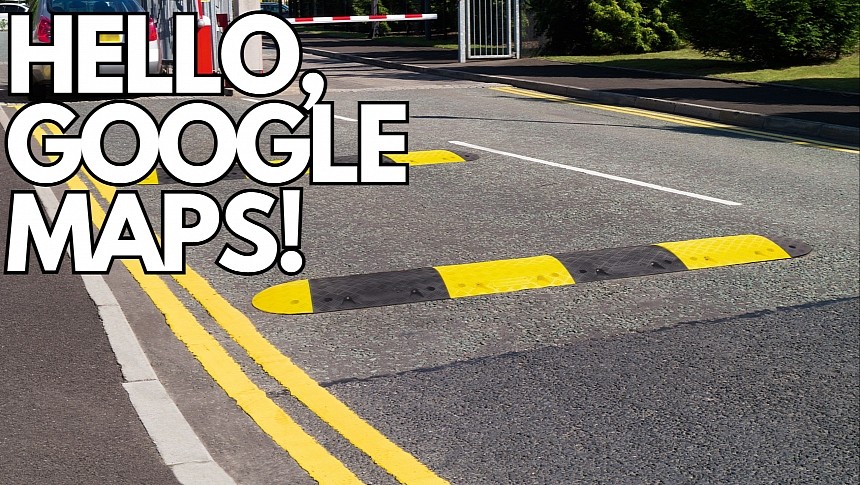Speed bumps are integral to traffic safety, and it's why authorities worldwide use them to force motorists to slow down in residential areas, close to schools, or when approaching a crosswalk.
Their efficiency is a no-brainer, but an imminent speed bump appearing out of nowhere can also become a double-edged sword. The driver can slam on the brakes, eventually increasing the risk of a rear-end collision.
Navigation apps can significantly help by showing warnings when approaching speed bumps. I've been a big advocate of this update, especially in Waze, an application that displays notifications for road hazards like accidents, broken traffic lights, and roadkill. Using crowdsourced data or information supplied by traffic authorities, sat-nav solutions can warn drivers when they approach a speed bump, getting them prepared and providing additional time to slow down.
Google Maps could soon become the first app to get speed bump data with two big catches.
The first catch is the region-limited availability. Indian authorities in Pune have been looking for a way to integrate speed bump information into navigation apps, so a collaboration with tech companies could allow solutions like Google Maps to connect to a speed bump location database. Eventually, these applications would import all 2,500 speed bump locations in Pune, flagging them on the map and giving drivers enough time to adjust their speed.
The second catch concerns how Google Maps will show the data. Compared to Waze, Google Maps doesn't flood the driver with traffic hazard warnings, so I believe the application will only highlight the speed bump location on the map. Waze could offer a more useful integration by displaying a warning on the screen when approaching a speed bump.
Similar warnings are already available in Waze when approaching a railroad crossing, with a notification on the screen giving drivers more time to slow down and double-check that no train approaches.
Pune authorities acknowledge that while speed bumps are efficient, they come in different sizes, shapes, and patterns, so with Google Maps integration, every breaker would become more predictable.
The good news is that the sat-nav integration wouldn't be exclusive to Google Maps, so eventually, Waze, Apple Maps, and other applications targeting the Indian market could offer similar capabilities by accessing the same database.
Meanwhile, I'm still convinced speed bump warnings would make sense worldwide, especially in applications like Google Maps and Waze. Users can feed speed bump location information into these applications, especially in Waze, which exists thanks to a crowdsourcing engine that provides its system with up-to-date traffic information.
Neither Google nor Waze (also a Google asset) commented on the speed bump integration into their navigation engines, though the latter once promised to bring this feature to users (without actually providing any ETA as to when it could happen).
Navigation apps can significantly help by showing warnings when approaching speed bumps. I've been a big advocate of this update, especially in Waze, an application that displays notifications for road hazards like accidents, broken traffic lights, and roadkill. Using crowdsourced data or information supplied by traffic authorities, sat-nav solutions can warn drivers when they approach a speed bump, getting them prepared and providing additional time to slow down.
Google Maps could soon become the first app to get speed bump data with two big catches.
The first catch is the region-limited availability. Indian authorities in Pune have been looking for a way to integrate speed bump information into navigation apps, so a collaboration with tech companies could allow solutions like Google Maps to connect to a speed bump location database. Eventually, these applications would import all 2,500 speed bump locations in Pune, flagging them on the map and giving drivers enough time to adjust their speed.
The second catch concerns how Google Maps will show the data. Compared to Waze, Google Maps doesn't flood the driver with traffic hazard warnings, so I believe the application will only highlight the speed bump location on the map. Waze could offer a more useful integration by displaying a warning on the screen when approaching a speed bump.
Similar warnings are already available in Waze when approaching a railroad crossing, with a notification on the screen giving drivers more time to slow down and double-check that no train approaches.
Pune authorities acknowledge that while speed bumps are efficient, they come in different sizes, shapes, and patterns, so with Google Maps integration, every breaker would become more predictable.
The good news is that the sat-nav integration wouldn't be exclusive to Google Maps, so eventually, Waze, Apple Maps, and other applications targeting the Indian market could offer similar capabilities by accessing the same database.
Meanwhile, I'm still convinced speed bump warnings would make sense worldwide, especially in applications like Google Maps and Waze. Users can feed speed bump location information into these applications, especially in Waze, which exists thanks to a crowdsourcing engine that provides its system with up-to-date traffic information.
Neither Google nor Waze (also a Google asset) commented on the speed bump integration into their navigation engines, though the latter once promised to bring this feature to users (without actually providing any ETA as to when it could happen).















